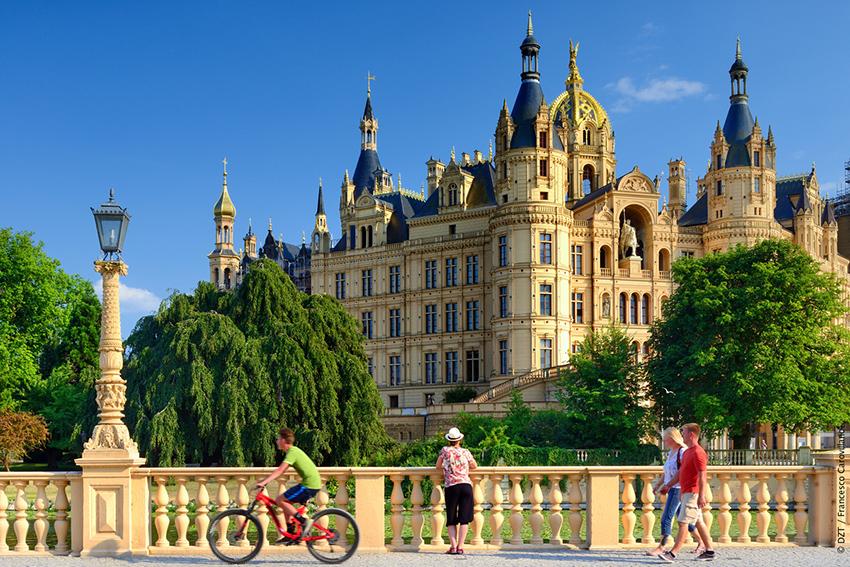Wander Through Germany’s Best UNESCO World Heritage Sites Germany's cultural heritage has received a significant boost with the recent addition of two new sites to the UNESCO World Heritage List


Wander Through Germany’s Best UNESCO World Heritage Sites-Cover Image
By PEAKLIFE
Germany has always been a country where history seems to breathe through every corner, and nowhere is this more evident than in its UNESCO World Heritage sites, which form the backbone of the country’s cultural soul. These world heritage sites represent a country that has played a key role in nearly every major European movement for over a thousand years—whether it’s political, cultural, intellectual, or religious.
Recently, Germany’s historical pedigree has received a significant boost with the addition of two new sites to the UNESCO World Heritage List. The UNESCO committee has recognised the Residence Ensemble Schwerin and the Saxon settlements of the Herrnhuter Brüdergemeine, bringing Germany to an impressive total of 54 UNESCO World Heritage sites. Spread across the country, these World Heritage Sites make Germany a perfect destination for those who love road trips or scenic train journeys, where you can hop from mediaeval towns to cutting-edge modern cities, all while soaking in centuries of heritage.
Take a look at the best UNESCO World Heritage sites you can visit in Germany!
The Residence Ensemble Schwerin
The Residence Ensemble Schwerin is a must-visit if you have a taste for history and culture. As one of Germany’s finest examples of 19th-century court culture, it blends the grandeur of its architecture with the natural beauty of its surroundings, making it a standout destination in the picturesque region of Mecklenburg-Vorpommern. At the heart of this UNESCO World Heritage site is Schwerin Palace, affectionately known as the “Neuschwanstein of the North.” With its ornate towers and scenic lakeside setting, the palace is a photographer’s dream and a cultural landmark. You can explore the historic court theatre, an insightful museum, and various administrative buildings that offer a glimpse into the region’s past. Schwerin, along with Mecklenburg-Vorpommern’s other UNESCO-listed gems—Stralsund and Wismar—form a cultural triangle that’s perfect to dive deep into Germany’s historical richness.
Moravian Brethren
The Herrnhuter Brüdergemeine, also known as the Moravian Brethren, is a fascinating stop for travellers interested in both history and architecture. Founded in the early 18th century in the Saxon town of Herrnhut, this religious community gained recognition for its innovative approach to social and religious life. What makes this settlement truly remarkable is its urban planning—it’s a model of thoughtful spatial organisation and architectural design, with every element reflecting the core principles of the Brethren. Exploring Herrnhut, you’ll notice the distinctive layout that has influenced over 30 similar settlements worldwide. This newly designated UNESCO World Heritage site is the third in Saxony, joining the ranks of Muskauer Park and the Ore Mountains.
Bayreuth-Margravial Opera House
The Margravial Opera House in Bayreuth is a Baroque masterpiece and an absolute must-see for history and architecture enthusiasts. Added to the UNESCO World Heritage List in 2012, this stunning opera house stands out as one of the few surviving theatres from the 18th century. Built in the mid-1700s, it’s an extraordinary example of Baroque design, with a lavish wooden interior adorned in intricate gold detailing. What’s truly remarkable is that almost everything in the opera house remains original—except for the stage curtain, which was famously stolen by Napoleon’s troops. If possible, take a tour of the Margravial Opera House as Princess Wilhelmine herself gives tourists a sound-and-light presentation.
Aachen Cathedral
Aachen Cathedral is one of Germany’s most iconic landmarks and a UNESCO World Heritage Site that carries immense historical and architectural significance. Located in the city of Aachen, this stunning cathedral dates back to the 8th century and was built by Emperor Charlemagne, making it one of the oldest cathedrals in Europe. The cathedral is a breathtaking blend of different architectural styles, combining Carolingian, Gothic, and Romanesque elements. Its centrepiece, the Palatine Chapel, is a masterpiece of mediaeval architecture, with its octagonal design and intricate mosaics that reflect Byzantine influence. The chapel’s marble columns, gold-tiled ceiling, and impressive throne of Charlemagne will transport you to a time when Aachen was the heart of the Holy Roman Empire.
Town of Bamberg
The Town of Bamberg is a charming gem located in Bavaria that stands out as a UNESCO World Heritage Site for its exceptionally well-preserved mediaeval architecture and historical significance. Wandering through Bamberg’s narrow alleys, admiring its grand churches, and soaking in its mediaeval ambiance offers a captivating glimpse into Germany’s rich past. One of Bamberg’s most striking features is its old town, famously known for its “Bamberg Altstadt,” which boasts an array of architectural styles, including Romanesque, Gothic, and Baroque. While you’re in Bamberg, visit the Bamberg Cathedral, a Romanesque masterpiece with impressive sculptures and a rich history dating back to the 11th century. The Old Town Hall, perched charmingly over the Regnitz River, is another must-see.
Cover Credits : The German National Tourist Office
More from our site
Recent Posts
Shaping Tomorrow’s Golf Champions With Leela Palace Bengaluru
The 3rd edition of The Leela Golf Tournament celebrated young talent and brought together skill, precision and camaraderie!
The 3rd edition of The Leela Golf Tournament celebrated young talent and brought together skill,…
The Duo Behind KAIA Goa & Gigi Bombay, Redefines Hospitality
In conversation with the founders of Pawan Shahri and Nikita Harisinghani, the duo behind Chrome Hospitality Asia
In conversation with the founders of Pawan Shahri and Nikita Harisinghani, the duo behind Chrome…
Precision, Durability, and Swiss Legacy
Victorinox launches the Swiss Army collection, featuring three distinct models that emphasise exceptional quality, resistance and versatility
Victorinox launches the Swiss Army collection, featuring three distinct models that emphasise exceptional quality, resistance…
A New Era of Luxury Interiors With Sussanne & Gauri Khan
Sussanne Khan & Gauri Khan unite to bring an awe-inspiring, six-storey sanctuary of luxury, art, and design in Hyderabad
Sussanne Khan & Gauri Khan unite to bring an awe-inspiring, six-storey sanctuary of luxury, art,…
Air India x Lufthansa: Fly To These International Destinations Now
Expanding their codeshare partnership, Air India and Lufthansa Group have added 100 new routes to their combined network
Expanding their codeshare partnership, Air India and Lufthansa Group have added 100 new routes to…
Luxury’s Most Recent & Vibrant Launches This Season
The luxury landscape is brimming with bold innovations, striking partnerships, and immersive experiences
The luxury landscape is brimming with bold innovations, striking partnerships, and immersive experiences

